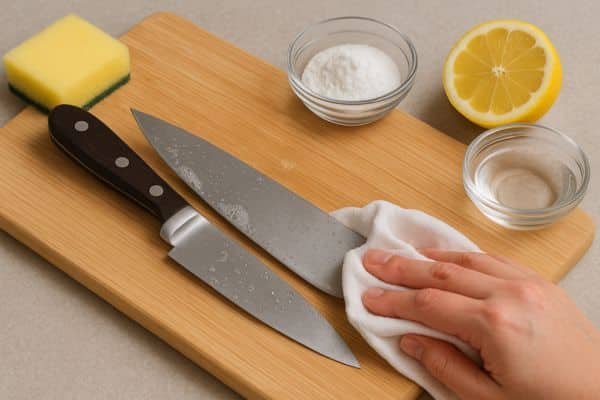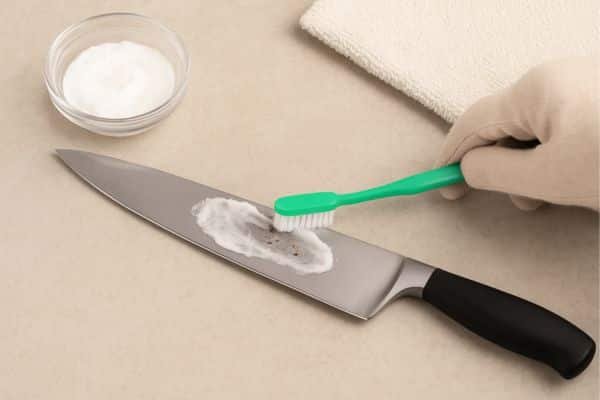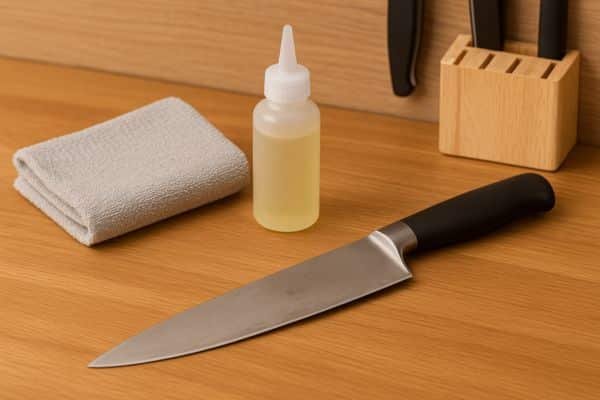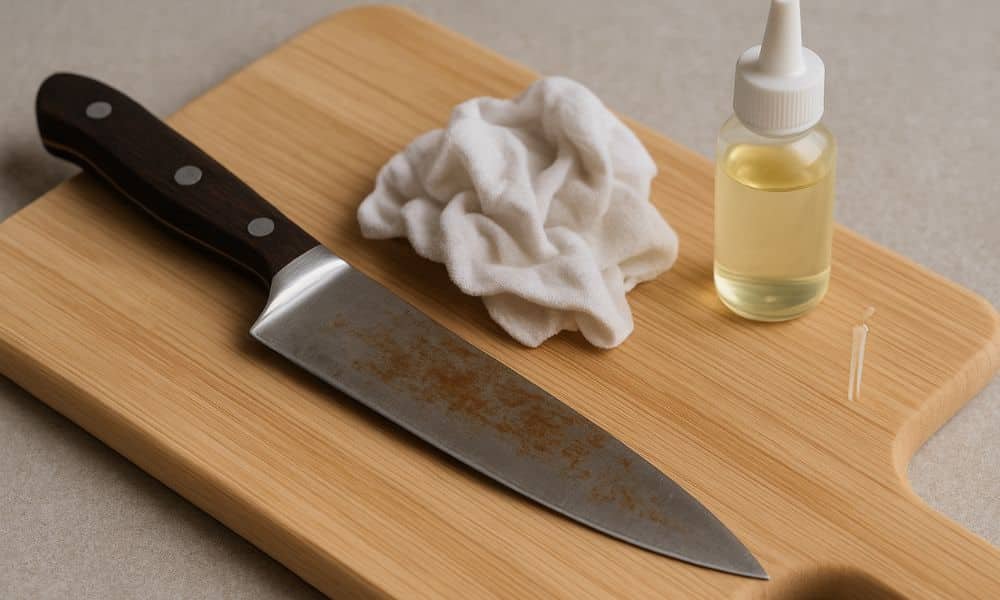I once grabbed my favourite knife to slice some ripe mangoes. The sun was out, and I was ready for a sweet snack. But as I opened the drawer, I saw a patch of rust near the handle. My heart sank. That knife had helped me through so many meals. Holiday dinners. Late-night noodles. Birthday cakes. Seeing it stained felt like finding a scratch on an old photo. Rust is sneaky. Water stays on the blade. The air gets in. Then, that clean silver edge turns dull and spotted. But don’t worry—it’s not the end. In this guide, you’ll learn how to get rust off a kitchen knife the easy way. These are real steps I’ve used in my own home with great results. You’ll also get smart tips for kitchen knife care to help keep your blades sharp and clean.
What Causes Rust on a Kitchen Knife?
Rust starts small. A tiny spot near the edge. A dull mark along the blade. But it means something—the metal is breaking down.
Rust forms when metal touches water and air. This causes a reaction called oxidation. Most kitchen knives have iron in the steel. Iron reacts fast, even to a little moisture.
Salt speeds things up. So do lemon juice, tomato juice, and onion scraps. These foods leave acids and salt on the blade. Left alone, they eat into the steel.
How you store the knife matters too. A wet drawer, a damp cloth, or a pile of other tools—these trap water around the blade.
Before You Start: What You’ll Need
Getting rid of rust is easier than most people think. You don’t need fancy tools or special sprays. Most items are already in your kitchen.
Start with the basics. You’ll need baking soda, white vinegar, a fresh lemon, a soft cloth, and a sponge. These work well for light to medium rust. They’re safe for your blade and gentle on your hands.
For tougher spots, try steel wool or eraser. These help remove deep stains without scratching too much. Use light pressure and go slow.
To protect the blade after cleaning, have some knife oil or food-safe mineral oil ready. A thin coat keeps moisture away and helps the knife stay clean longer. For those looking to maintain their knives in top condition, even when using a Best Kitchen Knife Set Under 100, this simple step makes a big difference.
Step-by-Step Guide
You don’t need harsh chemicals to fix a rusty blade. The steps are simple, and most of the tools are already in your kitchen. Follow this process to get your knife clean and sharp again.
01 . Wash and Dry the Knife

Start with a clean surface. Use warm water and mild soap. Scrub gently with a soft sponge. Dry the knife right away with a clean towel.
02. Pick a Natural Rust Remover
You have three great options: baking soda, white vinegar, or lemon juice. Each one works in a slightly different way. All are safe and gentle on steel..
03. Apply and Wait

For baking soda, mix it with a little water to form a paste. Spread it over the rust spots. For vinegar or lemon, soak a cloth and wrap it around the blade. Let it sit for 10 to 15 minutes.
04. Scrub the Rust Gently
Use a soft sponge or toothbrush. Scrub in small circles. Don’t press too hard—you want to remove rust, not scratch the steel.
05. Rinse and Dry Completely
Rinse the blade with warm water. Make sure all of the paste or juice is gone. Dry the knife fully with a soft towel.
06. (Optional)Oil the Blade
Rub a small drop of food-safe mineral oil or knife oil along the blade. This keeps moisture away and adds a protective coat.
Top Methods Compared: Which Rust Removal Trick Works Best?
There’s more than one way to clean blade. You don’t need to guess. Each method has strengths. Here’s how to choose the right one for your knife.
Baking Soda: Gentle and Safe
Best for: Light surface
How it works: Mix baking soda with water to make a paste. Spread it over rust. Let it sit. Scrub gently.
Pros:
- Easy to use
- Safe for most knives
- Won’t harm your hands
Cons:
- Takes longer for deep stains
- Needs scrubbing to work
Vinegar: Strong and Effective
Best for: Deep rust spots or older stains
How it works: Soak a cloth in white vinegar. Wrap the blade. Let it rest for 10–15 minutes. Scrub with care.
Pros:
- Cuts through deep
- Cheap and fast
- No mixing needed
Cons:
- Strong smell
- Can dull shiny blades
Lemon Juice: Quick and Natural
Best for: Small patches or touch-ups
How it works: Squeeze lemon juice on a cloth. Rub over areas. Let it sit for 5–10 minutes. Wipe and rinse.
Pros:
- Smells fresh
- Works fast
- Gentle on hands
Cons:
- Not strong enough for thick
- May need repeated tries
Knife Care Tips to Prevent Rust in the Future

A clean knife is a happy knife. With a few easy habits, you can keep rust away for good. Here’s how to take care of your blade and make it last longer.
Store It the Right Way
Use a knife block, magnetic strip, or blade guard. Keep it dry and away from wet tools. Don’t toss it in a drawer—blades can chip and trap moisture.
Dry It Right After Washing
Always dry your knife with a clean towel. Don’t let it air dry. Even one drop of water can start rust. Make this a habit after every use.
Skip the Dishwasher
Dishwashers are tough on knives. The heat, steam, and harsh soap wear down the steel. It’s better to wash by hand and dry right away.
Oil the Blade Now and Then
Use a drop of food-safe oil once a week or after heavy use. Rub it along the blade with a soft cloth. This adds a layer that keeps out air and water.
When to Replace or Professionally Restore Your Knife
Not every knife can be saved at home. Some damage goes too deep. Knowing when to call in help—or start fresh—can save time and effort.
Look for Deep Corrosion
Tiny spots are easy to fix. But deep rust that eats into the blade is a sign of serious wear. You may see pits, cracks, or parts of the edge flaking off.
Know When DIY Isn’t Enough
If your knife feels weak, bends, or has lost its edge after cleaning, it may need more than a scrub. Home tricks help with surface rust. But dull or chipped blades often need pro sharpening or repairs.
How to Choose a Quality New Knife
Look for high-carbon stainless steel for better rust resistance. A full tang blade (where the metal runs through the handle) offers balance and strength. Choose one that feels solid in your hand.
Final Thoughts
Rust happens. But it doesn’t mean your knife is done. With the right steps, you can fix it fast. Start simple. Use baking soda for small spots. Try vinegar for deep stains. Lemon is great for light, fresh rust.
Keep your knife dry. Don’t use the dishwasher. Store it in a clean, dry space. Add a light coat of oil now and then. Now you know how to get rust and how to keep it that way. Give your knife the care it needs, and it will stay sharp, strong, and ready for years to come.

